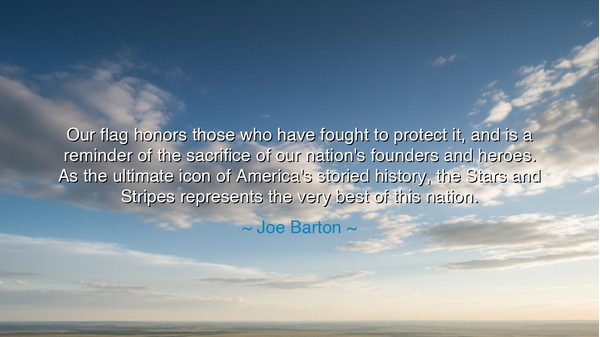
Our flag honors those who have fought to protect it, and is a
Our flag honors those who have fought to protect it, and is a reminder of the sacrifice of our nation's founders and heroes. As the ultimate icon of America's storied history, the Stars and Stripes represents the very best of this nation.






The American statesman Joe Barton once proclaimed: “Our flag honors those who have fought to protect it, and is a reminder of the sacrifice of our nation’s founders and heroes. As the ultimate icon of America’s storied history, the Stars and Stripes represents the very best of this nation.” In these words, he captures the sacred essence of the American flag — not merely as fabric and color, but as a living symbol of the country’s heart, its struggles, and its triumphs. His statement reminds us that behind every fold of the flag lies the blood of the brave, the dreams of the free, and the endurance of a people who have refused to surrender their ideals.
The origin of this quote reflects the long American tradition of reverence toward the flag as a vessel of memory and meaning. Barton, a public servant of the United States Congress, spoke these words to reaffirm that the flag’s true power lies not in its physical form, but in what it represents — the sacrifice of the founders, the courage of soldiers, and the unity of generations who built a nation from struggle and hope. The Stars and Stripes, born in revolution and tempered through centuries of trial, stands not as a banner of conquest, but as a testament to perseverance — to liberty defended and justice pursued through the ages.
The flag itself, with its thirteen stripes and fifty stars, is a symbol layered in history. The stripes recall the original colonies — a people who cast off tyranny in the name of self-rule — while the stars shine for every state that joined the union, each one a promise renewed that freedom would endure. Yet the flag’s meaning has deepened with time. It flew above the ramparts of Fort McHenry as Francis Scott Key, witnessing the bombardment, saw it still waving “by the dawn’s early light,” and knew that the young republic had survived. It was raised again at Iwo Jima, on a hill of sacrifice, and at Ground Zero after the towers fell, when smoke and sorrow filled the air. Each time, the Stars and Stripes declared not victory alone, but resilience — the refusal of the American spirit to be broken.
In his words, Barton calls the flag “the ultimate icon of America’s storied history.” This is no idle phrase. An icon, in the ancient sense, is not merely an image but a bridge between the visible and the eternal. The flag connects generations of Americans across time — from the farmers who fought at Lexington, to the sailors of Midway, to the firefighters who ran into the flames on September 11th. It is the cloth that drapes the coffins of the fallen, the banner that schoolchildren salute, the emblem that flies in distant lands as a symbol of both hope and responsibility. To honor it is to remember all who lived and died beneath its promise.
And yet, Barton’s message carries more than pride — it carries duty. For he reminds us that the flag “honors those who have fought to protect it,” which means that our reverence must not stop at ceremony. To honor the flag is to live in accordance with the values it embodies: freedom, equality, justice, and unity. These ideals were not given — they were earned, and they must be defended not only on battlefields but in our daily lives, through acts of courage, integrity, and compassion. The flag is not a relic of the past; it is a living challenge to every generation to prove itself worthy of the inheritance it represents.
Consider, for example, the story of the Apollo 11 mission. When Neil Armstrong and Buzz Aldrin planted the American flag on the moon in 1969, it was not a symbol of conquest, but of humanity’s shared ascent — a sign that a free nation, born of revolution, could turn its spirit of exploration toward the stars. In that moment, the flag was both earthly and eternal — a reminder that America’s greatness lies not in its power, but in its pursuit of possibility. It flew not only for one people, but for the idea that liberty, knowledge, and courage can transcend the limits of the world itself.
Therefore, let this be the lesson drawn from Joe Barton’s words: to honor the flag is to honor the story of sacrifice and renewal that it tells. Do not look upon it with casual eyes, nor treat it as a mere ornament. Let it remind you that freedom demands vigilance, that unity requires humility, and that patriotism is not blind pride, but an active devotion to the best within us. When you see the Stars and Stripes, remember those who carried it through fire and rain, and ask yourself — what will you do to carry its meaning forward?
For the flag, as Barton said, “represents the very best of this nation.” And the best of this nation is not found in wealth or might, but in the courage of its people, the compassion of its citizens, and the enduring light of its ideals. So let the flag wave not only in the wind, but in the soul of every American — a symbol not just of what has been won, but of what still must be protected, cherished, and renewed for generations to come.






AAdministratorAdministrator
Welcome, honored guests. Please leave a comment, we will respond soon